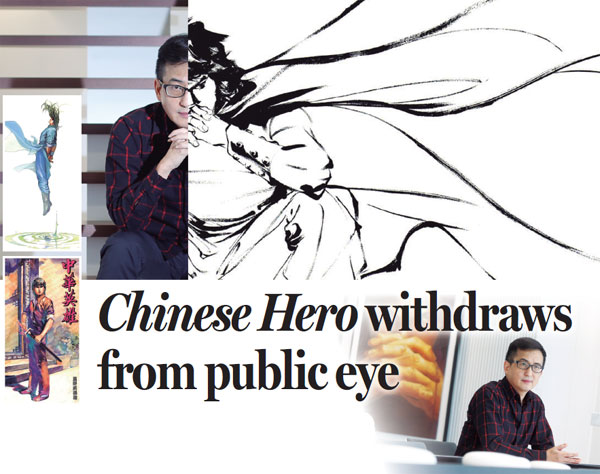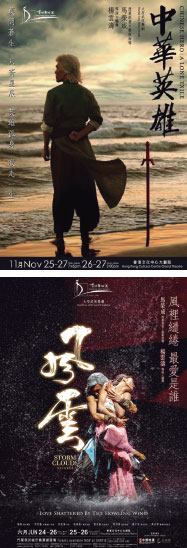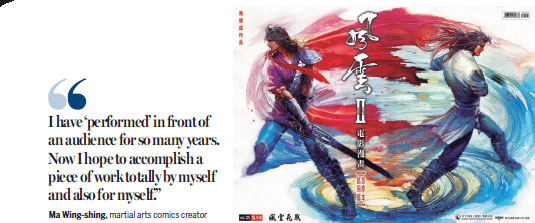Chinese Hero withdraws from public eye
Updated: 2017-01-10 07:25
By Dara Wang(HK Edition)
|
|||||||
The comics creator Ma Wing-shing only paints for himself these days, even as his creations continue to inspire newer stage and film adaptations. Dara Wang met the reclusive artist.
We met Ma Wing-shing at his office in Kwun Tong - a sprawling 900-square-meter space across two floors. He was in a smart casual suit, color-coordinated with the dcor of his work space to an extent. Both were about dark tones with minimum use of patterns, giving out a vibe of calmness. Ma's personal style, however, is in direct contrast with the one manifest in his cartoon creations - often swarthy full-blooded martial arts heroes, with strong jawlines. Unlike his be-calming, monochromatic office interiors, there is a lot of red - of blood and fire - in the scenes that Ma paints.
Influenced by Japanese comics creators such as Katsuhiro Otomo, Ryoichi Ikegami and Takumi Nagayasu, Ma's realistic drawing style marked a departure from the violence and gore that was the staple of Hong Kong comics during the 1970s. In his Chinese Hero series, Ma added a fresh spin using delicate brushwork to the tradition of then Chinese comics, also known as manhua, which depicts figures in a rough style - big heads, knife-shaped brows and rounded eyes. The comics gradually gained popularity after being serialized in the 1980s. One edition sold an unprecedented 200,000 copies in 1988.

Today 56-year-old Ma's creations continue to draw the crowds, in their original as well as adapted forms. A dance drama adaptation of Ma's Chinese Hero by Hong Kong Dance Company debuted in November 2016, following up on their earlier production based on another much-loved work by Ma, Fung Wan, which has become something of a signature piece for the company. The comics series, hugely popular when they were published for the first time in 1989, has helped bankroll Ma's company, Jonesky (HK) Ltd, for some 25 years.
Over the years, Ma has proved to be as much of a successful businessman as a talented cartoonist. Might be interesting to turn the clock back and go over how he made it to this point in his life.
Far from perfect

Ma lost his father at the age of 3 and was raised by his mother single-handedly. So he started with a bit of a handicap when he began his career as a graphic story-teller, not having any first-hand experience of the dynamics of a father-son relationship.
"Honestly, I didn't know how to portray the relationship between the protagonist of Chinese Hero Wah Ying-hung and his son Wah Kim-hung," Ma said. "My father passed away when I was very little, so I do not have any memory of being with a father, even for a single day."

The void in his personal life could have informed the way he visualized some of his cartoon characters. Wah Kim-hung had lost an arm. Nip Fung, in Fung Wan, was blind in one eye. The idea of making his protagonists physically-flawed is meant to reflect reality, where people are often far from perfect.
As an artist, however, Ma is forever striving to achieve perfection in his work. Like he would in the very early stage of his career, Ma still draws obsessively every day. There was a time when Ma would work more than 10 hours a day, sleep in his office at night and would only return home once a week to have dinner with his family.
So which of his characters did he identify the most at the time?
Ma goes for Mo Dik, a villain in Chinese Hero. Mo Dik, says Ma, is a simple-minded person who gives up everything he owns, including his family members and loyal servant, not wishing to get distracted from his goal of achieving excellence in martial arts.
"Maybe it sounds crazy, but the truth is that I have never visited a bank, rode a bicycle or went to a hospital to get a health check done before I finished the final chapter of Fung Wan a few years ago," Ma said. "But I never regretted devoting myself to creating art. It is my only passion and purpose in life," he added, with a candidness that only small children are capable of.
Emulating his own
Younger fans might associate Ma's name more with Fung Wan than Chinese Hero, as the former spawned a few movies, a TV series and video game adaptations, and has been in public imagination continuously since the past 20 years. Its two protagonists Nip Fung and Bou Ging-wan were inspired by a conversation Ma had with a famous fortune-teller. Ma was 23 then. He wanted the fortune-teller's advice on whether he should start his own business.
Ma was told his future will be as successful as a dragon flying to heaven, aided by the wind and clouds. So Nip Fung and Bou Ging-wan, representing the winds and clouds, were created. Ma hoped the two would bring success to his career.
He seems to like Bou Ging-wan much more than Nip Fung though. "I appreciate Bou for his daring and doing what he thinks is right, without caring much what others think about him," Ma said. Ma gave Bou an especially powerful arm and a sword with which he would vanquish numerous martial arts masters and practice some of the most difficult martial arts moves.
When he started his publication, Ma says he was a bit like Bou - too confident of his chosen line without caring much for popular taste. He ran The Two Extremes in the first four issues. It was "a bold attempt to combine cartoon with fine arts". The characters from the comics' world were sometimes transposed to a more realistic, present-day setting, transiting space and time. However, the work failed to become a commercial hit and finally Ma gave it up.
Fung Wan followed The Two Extremes. It was more well-received than Chinese Hero, not the least because of the popular elements Ma had incorporated in the series. When commercial success happened, Ma realized he was going from being a cartoonist to a leader of a company, just like Nip, the "wind", concerned with the mundane, everyday affairs of life.
Fung Wan was published for over two decades, until Ma decided to end the cartoon series, "giving up his leading position in the market". "It was a hard decision that took me a couple of years to make. It is not easy to abandon the most profitable cartoon which had supported the company for such a long time," Ma said. And yet, it seemed he had run out of ideas and it was perhaps the right time to let go while the series was still highly-popular.
Now retired as a professional cartoonist, Ma works quietly on his new projects for his own interest. He is developing some side stories of Fung Wan. "That will become a private collection only available to me," Ma said.
"I have 'performed' in front of an audience for so many years. Now I hope to accomplish a piece of work totally by myself and also for myself," he added.
Fair enough, we say, considering Ma's creations will continue to bring joy and satisfaction to generations of readers who love the magic world conjured up by cartoons.
Contact the writer at
dara@chinadailyhk.com
(HK Edition 01/10/2017 page7)